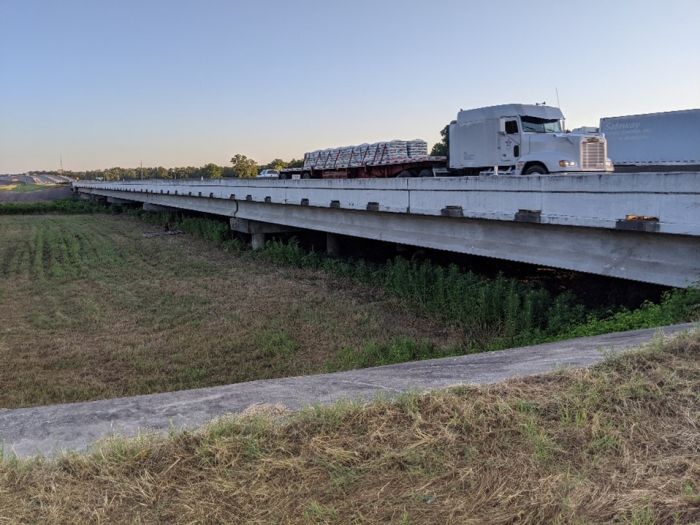







複雑な交通網の中で、橋は中心的な役割を果たし、コミュニティを結び付け、物資と人のスムーズな流れを確保しています。実績のある橋の設計 (単純支持の桁を使用) は、長い間伸縮継手に依存してきました。しかし、このタイプの継手には、漏水や桁端の損傷などの問題がつきまとい、より優れたソリューションの模索が始まりました。そこで登場したのがリンク スラブです。従来の伸縮継手に伴う面倒な作業がなく、デッキの柔軟性を継続的に維持できる有望な手段です。
この探求により、テキサス A&M 大学の研究者は、伸縮継手の欠点に対する潜在的な解決策としてリンク スラブを研究するようになりました。しかし、この革新的なソリューションを進めるにつれて、リンク スラブがさまざまな負荷の下でどのように動作するか、またひび割れや劣化の潜在的なリスクは何かという疑問が残りました。テキサス州の 5 つの橋で接着リンク スラブの動作を綿密に調査した現地調査を見てみましょう。
この革新的な研究活動を推進するテキサス A&M 大学の研究者たちは、リンク スラブの挙動を深く理解することの重要性を認識しました。彼らは協力して実践的な取り組みに乗り出し、5 つの橋に変位ゲージとひずみゲージを取り付けました。ミッションは明確で、さまざまな荷重と条件下でデータを収集し、接着リンク スラブの複雑さを解明することです。
研究者たちはどのようにしてデータを収集したのでしょうか。彼らは、Campbell Scientific CR6 自動監視プラットフォーム、Granite™ VWire 305 動的バイブレーティングワイヤ アナライザー、GEOKON バイブレーティングワイヤ変位およびひずみゲージなどのツールを使用した最先端の技術を活用しました。橋梁の選択も恣意的な作業ではありませんでした。研究者たちは、スパンの長さ、桁の種類、デッキ ユニットの長さなど、リンク スラブの動作に影響を与えるさまざまな特性を表す場所を慎重に特定しました。
CR6 自動監視プラットフォームは、設置後、GEOKON バイブレーティングワイヤ変位ゲージとサーミスタ内蔵ひずみゲージから継続的にデータを収集しました。洞察のための継続的なデータ ストリームを確保するために、CR6 プラットフォームは、それぞれ 100 アンペア時の容量を持つ 2 つの堅牢なバッテリーで駆動されました。各 CR6 には 8 つのゲージを収容できるため、テキサス A&M 大学の研究者は合計 16 個のゲージを設置でき、データ収集の豊富さと精度を高めることができました。
それでは、調査結果のハイライトを見てみましょう。
熱平衡:日中にバランスが取れるのと同じように、午前遅くまたは午後の早い時間に温度差が平準化される様子を想像してください。
変形:内部スパンのリンク スラブですか? 障壁や手すりによって剛性が増したため、外部桁のリンク スラブよりも熱負荷によって大きく曲がります。
設計への影響:フラッシュ プレキャスト パネル (PCP) の詳細について考えたことはありますか? それらはより柔軟ですが、オフセット PCP の詳細と比較してスパン間の連続性が多少犠牲になり、狭い領域に集中的にひび割れが生じる可能性があります。
デッキユニットと回転:これは数字の問題です。連続デッキのユニット数が多いほど、活荷重下での正回転が大きくなりますが、ユニット数が少ないと、熱荷重下での正回転と負回転の両方が大きくなります。
有効リンク スラブ長さ:魔法は桁端のデータにあり、研究者は有効リンク スラブ長さを計算するのに役立ちます。有効リンク スラブ長さは、リンク スラブの剛性とスパン間の連続性において重要な役割を果たします。
二重の考慮事項:熱と活荷重の影響が組み合わさって、桁端部の回転とリンク スラブの歪みに大きな影響を与えるため、設計では両方の考慮事項が必要であることが強調されます。
ひび割れひずみ:ここが興味深いところです。リンク スラブ コンクリートのひずみは、特に特定の設計詳細において、デッキの上部と下部でひび割れひずみの限界を超えることがよくあります。
縦方向の補強:しっかりしてください。リンク スラブの縦方向の補強のひずみは、特定の条件下では、フラッシュ PCP の詳細部分でのみ降伏ひずみに当たります。
これらの研究結果は、単なるパズルのピースではありません。よりスマートで耐久性の高い橋の設計への道を開く洞察です。テキサス A&M 大学は、研究活動を通じて、接着リンク スラブの動作に関する理解の限界を押し広げてきました。このケース スタディは、単なるデータの収集ではありません。橋の設計の未来を形作る革新的な思考の力を証明するものです。シートベルトを締めてください。これは橋だけの問題ではなく、私たち全員にとってよりスムーズで耐久性のある旅を築くことなのです。